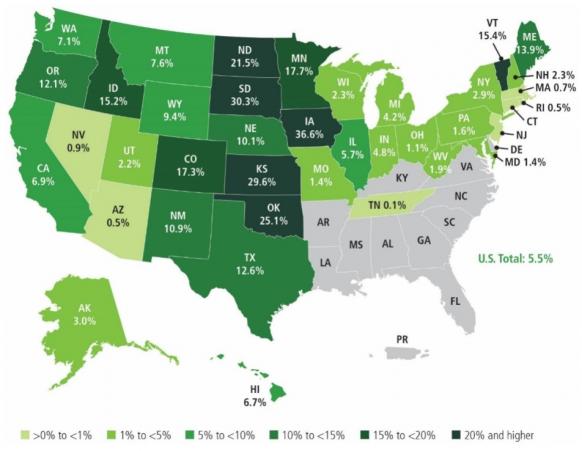Texas wind set for real-time forecast boost in move to faster dispatch
Grid operator ERCOT plans to roll-out intra-hour wind forecasting based on improved modelling while new research predicts a shift towards probabilistic forecasts could generate further gains, industry experts told New Energy Update.

Related Articles
Wind power forecasting and variability has become a high priority for system operators as they accommodate an increasing share of wind power into their grids.
In Texas, the leading wind power state, wind capacity is expected to climb to over 20 GW this year, increasing the pressure on grid operator Electric Reliability Council of Texas (ERCOT) to manage plant variability and optimize generation assets.
A recent study of ramp forecasting in Texas by NREL, the State University of New York and the University of Texas, warned that large ramps in wind production were one of the biggest concerns that could “significantly influence system economics and reliability.”
A Wind Forecast Improvement Project (WFIP) conducted by the researchers found that new forecast techniques applied in the ERCOT grid area improved the accuracy of wind power ramp forecasting and would generate "substantial cost savings.”
Improved forecasting would reduce the non-spinning reserve capacity ERCOT must procure to cover for large forecasting errors in wind and load, the study found.
Texas is continuing to apply a range of new technologies and expertise to improve its wind power forecasting accuracy, Sandip Sharma, ERCOT General Manager of Operations and Planning, told New Energy Update.
“Forecasting errors continue to decline in ERCOT. The day-ahead forecasting performance, expressed in mean absolute percentage error [MAPE], has steadily improved, from 8.32% in 2013 to 5.63% in 2016 - a 32.3% improvement in forecast accuracy,” Sharma noted.
ERCOT's current priorities include greater forecasting accuracy for all types of weather conditions, especially inclement weather.
“We are procuring a second wind forecasting vendor to provide supplemental forecasts for extreme weather events such as icy conditions in the ERCOT region," Sharma said.
"These new forecasts will provide both quantitative and qualitative assessments for the risk and estimated impact of extreme weather events on wind generation facilities in ERCOT,” he said.
The new forecasting resources should impact the cost of acquiring operational reserves, Sharma said.
"Improved wind forecasting could reduce the amount of operational reserves needed to ensure a reliable electric system - and reduce costs,” he said.
Five-minute warning
Wind forecasting vendors use different models and assumptions to generate forecasts.
Additional forecasting resources will allow ERCOT to select the most appropriate sources for its energy management systems and forecasting studies, Sharma said.
“One vendor may be better at short-term forecasting versus long-term forecasting. Collectively, multiple vendors help ensure ERCOT has good checks and balances in place to ensure we receive the most accurate wind forecasting data,” he said.
Plans also are underway to add intra-hour wind forecasting, which will help ERCOT schedule conventional generation more efficiently in real-time in response to expected variations in wind generation.
ERCOT currently uses hourly forecasting, receiving regular forecasts for the following 168 hours.
Intra-hour forecasting will provide the grid operator with a forecast for the next two hours, every five minutes, Sharma said.
"This additional forecasting capability will help our grid operators better prepare for potential ramps in wind generation at every five-minute interval, which aligns with our system dispatch intervals,” he said.
Wind power share of generation by state in 2016
(Click image to enlarge)

Source: American Wind Energy Association (AWEA).
Probability shift
The federal-funded WFIP research found the application of probabilistic forecasts, rather than deterministic methods, improved wind ramp forecasting.
Probabilistic forecasts use a range of different methods to determine the likelihood of events, factoring in uncertainties and conditional probabilities to generate probabilistic cumulative distribution curves. In wind forecasting, probabilistic forecasts rely more on model output statistics processes as well as enhanced computation and algorithms, to extrapolate for instance the likelihood of an extreme weather event.
Most utilities currently used deterministic forecast methods, which predict an event of a specific magnitude at a specific time and place, for example predicting wind power will be 100 MW in the next hour.
The latest forecasting trials are "looking at a more stochastic approach” which maximizes benefits from shorter scheduling intervals, Bri-Mathias Hodge, Manager of the power system design & studies group at NREL, told New Energy Update.
The key to this process is to "use uncertain information around the forecast so that you can inherently schedule the reserves you need, instead of doing it in an ad hoc fashion based on historical data," he said.
“You have better forecasts at shorter time periods [and] you also are eliminating artificial inaccuracies that arise from averaging over longer time periods,” Hodge said.
The advantage of probabilistic forecasts will increase as more grid operators move toward shorter dispatching notices, allowing them to apply more up to date forecasts, he noted.
Data collaboration
Going forward, improvements in forecasting procedures will depend upon close cooperation between wind forecasting service providers, wind farm operators, weather forecast systems and system operators, Sharma said.
“Wind forecasting is a very complicated, dynamic and system-dependent process that requires data sharing between these entities to provide the best forecasting outcome,” he said.
The expected removal of the wind production tax credit (PTC) and expiry of subsidies for older wind farms in the coming years will incentivize wind operators to help improve forecasting performance.
Forecasting tools will become increasingly important as wind becomes more integrated with grid services and wholesale markets, Hodge said.
“You already see some places like here in Colorado where Xcel Energy has wind providing regulation reserves, it’s on an automation generation control signal (AGC) so they tell their wind plants every four seconds to go up or down in order to help regulate the entire system ..so I think you will see more things like that,” he said.
By Richard Wachman
